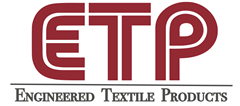Polyvinyl Chloride Geomembrane Liners – PVC Liners
In the 1950s PVC was first introduced to the synthetic liner industry and has become the standard material for many kinds of waste containment projects by both industries and municipalities. Government agencies, such as the U.S. Department of Interior regularly use PVC liners for the containment of precious water resources and the protection of the environment throughout the United States.
Seam integrity gives the reliability you need in every factory- manufactured panel of PVC. Factory seams are produced in a controlled environment for maximum bonding. It is done through methods of thermal and dielectric sealing. All factory seams meet the required values established by the National Sanitation Foundation (NSF). Quality control tests are continually run on these seams, including destructive seam testing. This all contributes to a PVC seam that gives you the strength and reliability you need.
Customized Panels mean lower installed costs. ETP PVC panel can be made in the factory in sizes ranging up to 30,000 square feet. Customized panels are particularly helpful in irregularly shaped installations, cutting material waste and reducing the number of field seams.
Field Seam Reliability is another way you can count on ETP’s PVC, because you can easily test all field seams on site to ensure their integrity. Using formulated solvents, crews can install up to 200,000 square feet a day without elaborate tools or equipment. All the field seams can then be checked with a simple air lance test.
Puncture and Impact Resistance starts in the PVC’s molecular structure. PVC has an amorphous molecular structure which allows PVC liners to conform to ground settling and irregular subgrades without yielding. Because it is not a crystalline structure like the other harder plastics, PVC has a low modulus of elasticity and no yield point. That means substantial dividends in three ways. First, environmental stress cracking is completely avoided when using PVC. Second, the buildup of stress on the liner membrane and its’ seams can eventually cause a yield failure even at low elongations. Since PVC does not have a yield point, failure will not occur in this situation. Third, regardless of thickness, PVC demonstrates 3-dimensional elongation properties (tri-axial deformation) making it more resistant to puncture and impact damage during both installation and during the design life of the liner system. Conclusive tests have proven what environmental engineers, installers, and project managers have known for years. PVC gives them the standard of reliability over time.
Effective Containment for Many Applications:
[one_half]
-
- Brine Storage Ponds
- Canal Linings
- Decorative Ponds
- Fish Rearing Ponds
- Mine Tailings
- Oil Reserve Pits
- Recreational Lakes
- Reservoirs
- Sanitary Landfills
[/one_half] [one_half last]
-
- Fly Ash Pads
- Geomembranes
- Heap Leach Pads
- Irrigation Water Storage
- Secondary Containment
- Sewage Aeration Ponds
- Sewage Settling Lagoons
- Wastewater Treatment Plants
- Caps and Solid Liners for Solid Waste Landfills
Engineered Textile Products, Inc. also fabricates and installs polypropylene and Evaloy™ materials. To learn more about our experience in these systems or how ETP can help you with your project requirements, please call 1-800-222-8277 or contact us here.
PHYSICAL REQUIREMENTS
| Property | Test Method | Specified Values | |
| Thickness mils (Nominal +/- 5%) |
ASTM D1593 | 30 | |
| Specific Gravity, min. | ASTM D792 | 1.20 | |
| Minimum Tensile (each direction) Breaking Factor (pounds/inch width) Elongation at Break (percent) Modulus (force) at 100% Elongation |
ASTM D882
ASTM D882 |
2300 69 350% 1000 (30.0) |
|
| Tear Resistance, lbs./in., min. (lbs., min.) |
ASTM D1004 | 300 (9.0) |
|
| Low Temperature, ºF | ASTM D1790 | -20 | |
| Dimensional Stability, % change, max. |
ASTM D1204 (212ºF, 15 min.) |
3.5 | |
| Water Extraction % loss, max. |
ASTM D3083 | 0.25 | |
| Volatility % loss, max. |
ASTM D1203 | .70 | |
| Resistance to Soil Burial, % change, max. Tensile Strength Elongation at Break Modulus at 100% Elongation |
ASTM D3083 | -5 -20 +20 |
|
| Hydrostatic Resistance, psi, min. | ASTM D751 | 85 | |
| Factory and Field Seam Requirements | |||
| Bonded Seam Strength (factory seam, breaking factor, ppi width) |
ASTM D3083 (As Modified in NSF 54) |
55.2 | |
| Peel Adhesion (pounds/inch, min.) |
ASTM D413 (As Modified in NSF 54) |
10 | |
The data shown above is the result of laboratory test and are intended to be used as a guide. No performance, fitness or any other warranty is intended, expressed or implied by this data.
